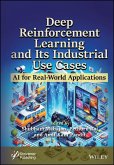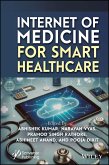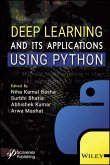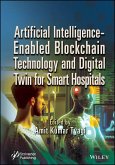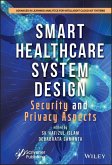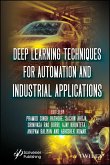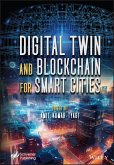Blockchain and Deep Learning for Smart Healthcare
Herausgeber: Singh, Akansha; Singh, Krishna Kant; Dhull, Anuradha
Blockchain and Deep Learning for Smart Healthcare
Herausgeber: Singh, Akansha; Singh, Krishna Kant; Dhull, Anuradha
- Gebundenes Buch
- Merkliste
- Auf die Merkliste
- Bewerten Bewerten
- Teilen
- Produkt teilen
- Produkterinnerung
- Produkterinnerung
The book discusses the popular use cases and applications of blockchain technology and deep learning in building smart healthcare. The book covers the integration of blockchain technology and deep learning for making smart healthcare systems. Blockchain is used for health record-keeping, clinical trials, patient monitoring, improving safety, displaying information, and transparency. Deep learning is also showing vast potential in the healthcare domain. With the collection of large quantities of patient records and data, and a trend toward personalized treatments. there is a great need for…mehr
Andere Kunden interessierten sich auch für
![Deep Reinforcement Learning and Its Industrial Use Cases Deep Reinforcement Learning and Its Industrial Use Cases]() Deep Reinforcement Learning and Its Industrial Use Cases207,99 €
Deep Reinforcement Learning and Its Industrial Use Cases207,99 €![Internet of Medicine for Smart Healthcare Internet of Medicine for Smart Healthcare]() Internet of Medicine for Smart Healthcare207,99 €
Internet of Medicine for Smart Healthcare207,99 €![Deep Learning and Its Applications Using Python Deep Learning and Its Applications Using Python]() Deep Learning and Its Applications Using Python179,99 €
Deep Learning and Its Applications Using Python179,99 €![Artificial Intelligence-Enabled Blockchain Technology and Digital Twin for Smart Hospitals Artificial Intelligence-Enabled Blockchain Technology and Digital Twin for Smart Hospitals]() Artificial Intelligence-Enabled Blockchain Technology and Digital Twin for Smart Hospitals207,99 €
Artificial Intelligence-Enabled Blockchain Technology and Digital Twin for Smart Hospitals207,99 €![Smart Healthcare System Design Smart Healthcare System Design]() Smart Healthcare System Design220,99 €
Smart Healthcare System Design220,99 €![Deep Learning Techniques for Automation and Industrial Applications Deep Learning Techniques for Automation and Industrial Applications]() Deep Learning Techniques for Automation and Industrial Applications179,99 €
Deep Learning Techniques for Automation and Industrial Applications179,99 €![Digital Twin and Blockchain for Smart Cities Digital Twin and Blockchain for Smart Cities]() Digital Twin and Blockchain for Smart Cities228,99 €
Digital Twin and Blockchain for Smart Cities228,99 €-
-
-
The book discusses the popular use cases and applications of blockchain technology and deep learning in building smart healthcare. The book covers the integration of blockchain technology and deep learning for making smart healthcare systems. Blockchain is used for health record-keeping, clinical trials, patient monitoring, improving safety, displaying information, and transparency. Deep learning is also showing vast potential in the healthcare domain. With the collection of large quantities of patient records and data, and a trend toward personalized treatments. there is a great need for automated and reliable processing and analysis of health information. This book covers the popular use cases and applications of both the above-mentioned technologies in making smart healthcare. Audience Comprises professionals and researchers working in the fields of deep learning, blockchain technology, healthcare & medical informatics. In addition, as the book provides insights into the convergence of deep learning and blockchain technology in healthcare systems and services, medical practitioners as well as healthcare professionals will find this essential reading.
Produktdetails
- Produktdetails
- Verlag: Wiley
- Seitenzahl: 480
- Erscheinungstermin: 31. Januar 2024
- Englisch
- Abmessung: 233mm x 155mm x 31mm
- Gewicht: 810g
- ISBN-13: 9781119791744
- ISBN-10: 111979174X
- Artikelnr.: 60688009
- Herstellerkennzeichnung
- Libri GmbH
- Europaallee 1
- 36244 Bad Hersfeld
- gpsr@libri.de
- Verlag: Wiley
- Seitenzahl: 480
- Erscheinungstermin: 31. Januar 2024
- Englisch
- Abmessung: 233mm x 155mm x 31mm
- Gewicht: 810g
- ISBN-13: 9781119791744
- ISBN-10: 111979174X
- Artikelnr.: 60688009
- Herstellerkennzeichnung
- Libri GmbH
- Europaallee 1
- 36244 Bad Hersfeld
- gpsr@libri.de
Akansha Singh, PhD, is an associate professor in the School of Computer Science Engineering and Technology, Bennett University, Greater Noida, India. Dr. Singh has acquired a BTech, MTech, and PhD (IIT Roorkee) in the area of neural networks and remote sensing. She has to her credit more than 70 research papers, 20 books, and numerous conference papers. She has also national and international patents in the field of machine learning. Her area of interest includes mobile computing, artificial intelligence, machine learning, and digital image processing. Anuradha Dhull, PhD, is an assistant professor in the Department of Computer Science Engineering, The NorthCap University, Gurugram, India. She has published more than 30 research papers in the area of data mining and machine learning. Dr. Anuradha has acquired a BTech, MTech, and PhD in the area of medical diagnosis and machine learning. Krishna Kant Singh, PhD, is a professor at the Delhi Technical Campus, Greater Noida, India. Dr. Singh has acquired a BTech, MTech, and PhD (IIT Roorkee) in the area of deep learning and remote sensing. He has authored more than 80 technical books and research papers in international conferences and SCIE journals of repute.
Preface xv
Part 1: Blockchain Fundamentals and Applications 1
1 Blockchain Technology: Concepts and Applications 3
Hermehar Pal Singh Bedi, Valentina E. Balas, Sukhpreet Kaur and Rubal Jeet
1.1 Introduction 3
1.2 Blockchain Types 4
1.3 Consensus 8
1.4 How Does Blockchain Work? 10
1.5 Need of Blockchain 12
1.6 Uses of Blockchain 12
1.7 Evolution of Blockchain 14
1.8 Blockchain in Ethereum 17
1.9 Advantages of Smart Contracts 21
1.10 Use Cases of Smart Contracts 21
1.11 Real-Life Example of Smart Contracts 22
1.12 Blockchain in Decentralized Applications 22
1.13 Decentraland 25
1.14 Challenges Faced by Blockchain 27
1.15 Weaknesses of Blockchain 29
1.16 Future of Blockchain 30
1.17 Conclusion 31
2 Blockchain with Federated Learning for Secure Healthcare Applications 35
Akansha Singh and Krishna Kant Singh
2.1 Introduction 36
2.2 Federated Learning 36
2.3 Motivation 37
2.4 Federated Machine Learning 38
2.5 Federated Learning Frameworks 39
2.6 FL Perspective for Blockchain and IoT 39
2.7 Federated Learning Applications 41
2.8 Limitations 42
3 Futuristic Challenges in Blockchain Technologies 45
Arun Kumar Singh, Sandeep Saxena, Ashish Tripathi, Arjun Singh and Shrikant
Tiwari
3.1 Introduction 46
3.2 Blockchain 47
3.3 Issues and Challenges with Blockchain 53
3.4 Internet of Things (IoT) 58
3.5 Background of IoT 59
3.6 Conclusion 67
4 AIML-Based Blockchain Solutions for IoMT 73
Rishita Khurana, Manika Choudhary, Akansha Singh and Krishna Kant Singh
4.1 Introduction 74
4.2 Objective and Contribution 75
4.3 Security Challenges in Different Domains 76
4.4 Healthcare 77
4.5 Agriculture 77
4.6 Transportation 78
4.7 Smart Grid 78
4.8 Smart City 78
4.9 Smart Home 79
4.10 Communication 79
4.11 Security Attacks in IoT 81
4.12 Solutions for Addressing Security Using Machine Learning 83
4.13 Solutions for Addressing Security Using Artificial Intelligence 83
4.14 Solutions for Addressing Security Using Blockchain 86
4.15 Summary 88
4.16 Critical Analysis 89
4.17 Conclusion 89
5 A Blockchain-Based Solution for Enhancing Security and Privacy in the
Internet of Medical Things (IoMT) Used in e-Healthcare 95
Meenakshi and Preeti Sharma
5.1 Introduction: E-Health and Medical Services 96
5.2 Literature Review 98
5.3 Architecture of Blockchain-Enabled IoMT 101
5.4 Proposed Methodology 104
5.5 Conclusion and Future Work 108
6 A Review on the Role of Blockchain Technology in the Healthcare Domain
113
Aryan Dahiya, Anuradha, Shilpa Mahajan and Swati Gupta
6.1 Introduction 113
6.2 Systematic Literature Methodology 119
6.3 Applications of Blockchain in the Healthcare Domain 122
6.4 Blockchain Challenges 136
6.5 Future Research Directions and Perspectives 139
6.6 Implications and Conclusion 140
7 Blockchain in Healthcare: Use Cases 147
Utsav Sharma, Aditi Ganapathi, Akansha Singh and Krishna Kant Singh
7.1 Introduction 147
7.2 Challenges Faced in the Healthcare Sector 149
7.3 Use Cases of Blockchains in the Healthcare Sector 150
7.4 What is Medicalchain? 159
7.5 Implementing Blockchain in SCM 165
7.6 Why Use Blockchain in SCM 167
Part 2: Smart Healthcare 171
8 Potential of Blockchain Technology in Healthcare, Finance, and IoT: Past,
Present, and Future 173
Chetna Tiwari and Anuradha
8.1 Introduction 173
8.2 Types of Blockchain 175
8.3 Literature Review 177
8.4 Methodology and Data Sources 188
8.5 The Application of Blockchain Technology Across Various Industries 189
8.6 Conclusion 199
9 AI-Enabled Techniques for Intelligent Transportation System for Smarter
Use of the Transport Network for Healthcare Services 205
Meenakshi and Preeti Sharma
9.1 Introduction 206
9.2 Artificial Intelligence 208
9.3 Artificial Intelligence: Transport System and Healthcare 209
9.4 Artificial Intelligence Algorithms 211
9.5 AI Workflow 215
9.6 AI for ITS and e-Healthcare Tasks 216
9.7 Intelligent Transportation, Healthcare, and IoT 218
9.8 AI Techniques Used in ITS and e-Healthcare 221
9.9 Challenges of AI and ML in ITS and e-Healthcare 223
9.10 Conclusions 225
10 Classification of Dementia Using Statistical First-Order and
Second-Order Features 235
Deepika Bansal and Rita Chhikara
10.1 Introduction 236
10.2 Materials and Methods 238
10.3 Proposed Framework 239
10.4 Experimental Results and Discussion 247
10.5 Conclusion 251
11 Pulmonary Embolism Detection Using Machine and Deep Learning Techniques
257
Renu Vadhera, Meghna Sharma and Priyanka Vashisht
11.1 Introduction 257
11.2 The State-of-the-Art of PE Detection Models 260
11.3 Literature Survey 261
11.4 Publications Analysis 270
11.5 Conclusion 270
12 Computer Vision Techniques for Smart Healthcare Infrastructure 277
Reshu Agarwal
12.1 Introduction 278
12.2 Literature Survey 280
12.3 Proposed Idea 308
12.4 Results 316
12.5 Conclusion 317
13 Energy-Efficient Fog-Assisted System for Monitoring Diabetic Patients
with Cardiovascular Disease 323
Rishita Khurana, Manika Choudhary, Akansha Singh and Krishna Kant Singh
13.1 Introduction 324
13.2 Literature Review 326
13.3 Architectural Design of the Proposed Framework 328
13.4 Fog Services 330
13.5 Smart Gateway and Fog Services Implementation 337
13.6 Cloud Servers 338
13.7 Experimental Results 339
13.8 Future Directions 345
13.9 Conclusion 350
14 Medical Appliances Energy Consumption Prediction Using Various Machine
Learning Algorithms 353
Kaustubh Pagar, Tarun Jain, Horesh Kumar, Aditya Bhardwaj and Rohit Handa
14.1 Introduction 354
14.2 Literature Review 355
14.3 Methodology 356
14.4 Machine Learning Algorithms Used 364
14.5 Results and Analysis 368
14.6 Model Analysis 369
14.7 Conclusion and Future Work 374
Part 3: Future of Blockchain and Deep Learning 379
15 Deep Learning-Based Smart e-Healthcare for Critical Babies in Hospitals
381
Ritam Dutta
15.1 Introduction 382
15.2 Literature Survey 383
15.3 Evaluation Criteria 392
15.4 Results 393
15.5 Conclusion and Future Scope 394
16 An Improved Random Forest Feature Selection Method for Predicting the
Patient's Characteristics 399
K. Indhumathi and K. Sathesh Kumar
16.1 Introduction 400
16.2 Literature Survey 402
16.3 Dataset 403
16.4 Data Analysis 406
16.5 Data Pre-Processing 407
16.6 Feature Selection Methods 408
16.7 Variable Importance by Machine Learning Methods 414
16.8 Random Forest Feature Selection 415
16.9 Proposed Methodology 418
16.10 Results and Discussion 420
16.11 Conclusion 421
17 Blockchain and Deep Learning: Research Challenges, Open Problems, and
Future 425
Akansha Singh and Krishna Kant Singh
17.1 Introduction 426
17.2 Research Challenges 427
17.3 Open Problems 428
17.4 Future Possibilities 429
17.5 Conclusion 430
References 431
Index 433
Part 1: Blockchain Fundamentals and Applications 1
1 Blockchain Technology: Concepts and Applications 3
Hermehar Pal Singh Bedi, Valentina E. Balas, Sukhpreet Kaur and Rubal Jeet
1.1 Introduction 3
1.2 Blockchain Types 4
1.3 Consensus 8
1.4 How Does Blockchain Work? 10
1.5 Need of Blockchain 12
1.6 Uses of Blockchain 12
1.7 Evolution of Blockchain 14
1.8 Blockchain in Ethereum 17
1.9 Advantages of Smart Contracts 21
1.10 Use Cases of Smart Contracts 21
1.11 Real-Life Example of Smart Contracts 22
1.12 Blockchain in Decentralized Applications 22
1.13 Decentraland 25
1.14 Challenges Faced by Blockchain 27
1.15 Weaknesses of Blockchain 29
1.16 Future of Blockchain 30
1.17 Conclusion 31
2 Blockchain with Federated Learning for Secure Healthcare Applications 35
Akansha Singh and Krishna Kant Singh
2.1 Introduction 36
2.2 Federated Learning 36
2.3 Motivation 37
2.4 Federated Machine Learning 38
2.5 Federated Learning Frameworks 39
2.6 FL Perspective for Blockchain and IoT 39
2.7 Federated Learning Applications 41
2.8 Limitations 42
3 Futuristic Challenges in Blockchain Technologies 45
Arun Kumar Singh, Sandeep Saxena, Ashish Tripathi, Arjun Singh and Shrikant
Tiwari
3.1 Introduction 46
3.2 Blockchain 47
3.3 Issues and Challenges with Blockchain 53
3.4 Internet of Things (IoT) 58
3.5 Background of IoT 59
3.6 Conclusion 67
4 AIML-Based Blockchain Solutions for IoMT 73
Rishita Khurana, Manika Choudhary, Akansha Singh and Krishna Kant Singh
4.1 Introduction 74
4.2 Objective and Contribution 75
4.3 Security Challenges in Different Domains 76
4.4 Healthcare 77
4.5 Agriculture 77
4.6 Transportation 78
4.7 Smart Grid 78
4.8 Smart City 78
4.9 Smart Home 79
4.10 Communication 79
4.11 Security Attacks in IoT 81
4.12 Solutions for Addressing Security Using Machine Learning 83
4.13 Solutions for Addressing Security Using Artificial Intelligence 83
4.14 Solutions for Addressing Security Using Blockchain 86
4.15 Summary 88
4.16 Critical Analysis 89
4.17 Conclusion 89
5 A Blockchain-Based Solution for Enhancing Security and Privacy in the
Internet of Medical Things (IoMT) Used in e-Healthcare 95
Meenakshi and Preeti Sharma
5.1 Introduction: E-Health and Medical Services 96
5.2 Literature Review 98
5.3 Architecture of Blockchain-Enabled IoMT 101
5.4 Proposed Methodology 104
5.5 Conclusion and Future Work 108
6 A Review on the Role of Blockchain Technology in the Healthcare Domain
113
Aryan Dahiya, Anuradha, Shilpa Mahajan and Swati Gupta
6.1 Introduction 113
6.2 Systematic Literature Methodology 119
6.3 Applications of Blockchain in the Healthcare Domain 122
6.4 Blockchain Challenges 136
6.5 Future Research Directions and Perspectives 139
6.6 Implications and Conclusion 140
7 Blockchain in Healthcare: Use Cases 147
Utsav Sharma, Aditi Ganapathi, Akansha Singh and Krishna Kant Singh
7.1 Introduction 147
7.2 Challenges Faced in the Healthcare Sector 149
7.3 Use Cases of Blockchains in the Healthcare Sector 150
7.4 What is Medicalchain? 159
7.5 Implementing Blockchain in SCM 165
7.6 Why Use Blockchain in SCM 167
Part 2: Smart Healthcare 171
8 Potential of Blockchain Technology in Healthcare, Finance, and IoT: Past,
Present, and Future 173
Chetna Tiwari and Anuradha
8.1 Introduction 173
8.2 Types of Blockchain 175
8.3 Literature Review 177
8.4 Methodology and Data Sources 188
8.5 The Application of Blockchain Technology Across Various Industries 189
8.6 Conclusion 199
9 AI-Enabled Techniques for Intelligent Transportation System for Smarter
Use of the Transport Network for Healthcare Services 205
Meenakshi and Preeti Sharma
9.1 Introduction 206
9.2 Artificial Intelligence 208
9.3 Artificial Intelligence: Transport System and Healthcare 209
9.4 Artificial Intelligence Algorithms 211
9.5 AI Workflow 215
9.6 AI for ITS and e-Healthcare Tasks 216
9.7 Intelligent Transportation, Healthcare, and IoT 218
9.8 AI Techniques Used in ITS and e-Healthcare 221
9.9 Challenges of AI and ML in ITS and e-Healthcare 223
9.10 Conclusions 225
10 Classification of Dementia Using Statistical First-Order and
Second-Order Features 235
Deepika Bansal and Rita Chhikara
10.1 Introduction 236
10.2 Materials and Methods 238
10.3 Proposed Framework 239
10.4 Experimental Results and Discussion 247
10.5 Conclusion 251
11 Pulmonary Embolism Detection Using Machine and Deep Learning Techniques
257
Renu Vadhera, Meghna Sharma and Priyanka Vashisht
11.1 Introduction 257
11.2 The State-of-the-Art of PE Detection Models 260
11.3 Literature Survey 261
11.4 Publications Analysis 270
11.5 Conclusion 270
12 Computer Vision Techniques for Smart Healthcare Infrastructure 277
Reshu Agarwal
12.1 Introduction 278
12.2 Literature Survey 280
12.3 Proposed Idea 308
12.4 Results 316
12.5 Conclusion 317
13 Energy-Efficient Fog-Assisted System for Monitoring Diabetic Patients
with Cardiovascular Disease 323
Rishita Khurana, Manika Choudhary, Akansha Singh and Krishna Kant Singh
13.1 Introduction 324
13.2 Literature Review 326
13.3 Architectural Design of the Proposed Framework 328
13.4 Fog Services 330
13.5 Smart Gateway and Fog Services Implementation 337
13.6 Cloud Servers 338
13.7 Experimental Results 339
13.8 Future Directions 345
13.9 Conclusion 350
14 Medical Appliances Energy Consumption Prediction Using Various Machine
Learning Algorithms 353
Kaustubh Pagar, Tarun Jain, Horesh Kumar, Aditya Bhardwaj and Rohit Handa
14.1 Introduction 354
14.2 Literature Review 355
14.3 Methodology 356
14.4 Machine Learning Algorithms Used 364
14.5 Results and Analysis 368
14.6 Model Analysis 369
14.7 Conclusion and Future Work 374
Part 3: Future of Blockchain and Deep Learning 379
15 Deep Learning-Based Smart e-Healthcare for Critical Babies in Hospitals
381
Ritam Dutta
15.1 Introduction 382
15.2 Literature Survey 383
15.3 Evaluation Criteria 392
15.4 Results 393
15.5 Conclusion and Future Scope 394
16 An Improved Random Forest Feature Selection Method for Predicting the
Patient's Characteristics 399
K. Indhumathi and K. Sathesh Kumar
16.1 Introduction 400
16.2 Literature Survey 402
16.3 Dataset 403
16.4 Data Analysis 406
16.5 Data Pre-Processing 407
16.6 Feature Selection Methods 408
16.7 Variable Importance by Machine Learning Methods 414
16.8 Random Forest Feature Selection 415
16.9 Proposed Methodology 418
16.10 Results and Discussion 420
16.11 Conclusion 421
17 Blockchain and Deep Learning: Research Challenges, Open Problems, and
Future 425
Akansha Singh and Krishna Kant Singh
17.1 Introduction 426
17.2 Research Challenges 427
17.3 Open Problems 428
17.4 Future Possibilities 429
17.5 Conclusion 430
References 431
Index 433
Preface xv
Part 1: Blockchain Fundamentals and Applications 1
1 Blockchain Technology: Concepts and Applications 3
Hermehar Pal Singh Bedi, Valentina E. Balas, Sukhpreet Kaur and Rubal Jeet
1.1 Introduction 3
1.2 Blockchain Types 4
1.3 Consensus 8
1.4 How Does Blockchain Work? 10
1.5 Need of Blockchain 12
1.6 Uses of Blockchain 12
1.7 Evolution of Blockchain 14
1.8 Blockchain in Ethereum 17
1.9 Advantages of Smart Contracts 21
1.10 Use Cases of Smart Contracts 21
1.11 Real-Life Example of Smart Contracts 22
1.12 Blockchain in Decentralized Applications 22
1.13 Decentraland 25
1.14 Challenges Faced by Blockchain 27
1.15 Weaknesses of Blockchain 29
1.16 Future of Blockchain 30
1.17 Conclusion 31
2 Blockchain with Federated Learning for Secure Healthcare Applications 35
Akansha Singh and Krishna Kant Singh
2.1 Introduction 36
2.2 Federated Learning 36
2.3 Motivation 37
2.4 Federated Machine Learning 38
2.5 Federated Learning Frameworks 39
2.6 FL Perspective for Blockchain and IoT 39
2.7 Federated Learning Applications 41
2.8 Limitations 42
3 Futuristic Challenges in Blockchain Technologies 45
Arun Kumar Singh, Sandeep Saxena, Ashish Tripathi, Arjun Singh and Shrikant
Tiwari
3.1 Introduction 46
3.2 Blockchain 47
3.3 Issues and Challenges with Blockchain 53
3.4 Internet of Things (IoT) 58
3.5 Background of IoT 59
3.6 Conclusion 67
4 AIML-Based Blockchain Solutions for IoMT 73
Rishita Khurana, Manika Choudhary, Akansha Singh and Krishna Kant Singh
4.1 Introduction 74
4.2 Objective and Contribution 75
4.3 Security Challenges in Different Domains 76
4.4 Healthcare 77
4.5 Agriculture 77
4.6 Transportation 78
4.7 Smart Grid 78
4.8 Smart City 78
4.9 Smart Home 79
4.10 Communication 79
4.11 Security Attacks in IoT 81
4.12 Solutions for Addressing Security Using Machine Learning 83
4.13 Solutions for Addressing Security Using Artificial Intelligence 83
4.14 Solutions for Addressing Security Using Blockchain 86
4.15 Summary 88
4.16 Critical Analysis 89
4.17 Conclusion 89
5 A Blockchain-Based Solution for Enhancing Security and Privacy in the
Internet of Medical Things (IoMT) Used in e-Healthcare 95
Meenakshi and Preeti Sharma
5.1 Introduction: E-Health and Medical Services 96
5.2 Literature Review 98
5.3 Architecture of Blockchain-Enabled IoMT 101
5.4 Proposed Methodology 104
5.5 Conclusion and Future Work 108
6 A Review on the Role of Blockchain Technology in the Healthcare Domain
113
Aryan Dahiya, Anuradha, Shilpa Mahajan and Swati Gupta
6.1 Introduction 113
6.2 Systematic Literature Methodology 119
6.3 Applications of Blockchain in the Healthcare Domain 122
6.4 Blockchain Challenges 136
6.5 Future Research Directions and Perspectives 139
6.6 Implications and Conclusion 140
7 Blockchain in Healthcare: Use Cases 147
Utsav Sharma, Aditi Ganapathi, Akansha Singh and Krishna Kant Singh
7.1 Introduction 147
7.2 Challenges Faced in the Healthcare Sector 149
7.3 Use Cases of Blockchains in the Healthcare Sector 150
7.4 What is Medicalchain? 159
7.5 Implementing Blockchain in SCM 165
7.6 Why Use Blockchain in SCM 167
Part 2: Smart Healthcare 171
8 Potential of Blockchain Technology in Healthcare, Finance, and IoT: Past,
Present, and Future 173
Chetna Tiwari and Anuradha
8.1 Introduction 173
8.2 Types of Blockchain 175
8.3 Literature Review 177
8.4 Methodology and Data Sources 188
8.5 The Application of Blockchain Technology Across Various Industries 189
8.6 Conclusion 199
9 AI-Enabled Techniques for Intelligent Transportation System for Smarter
Use of the Transport Network for Healthcare Services 205
Meenakshi and Preeti Sharma
9.1 Introduction 206
9.2 Artificial Intelligence 208
9.3 Artificial Intelligence: Transport System and Healthcare 209
9.4 Artificial Intelligence Algorithms 211
9.5 AI Workflow 215
9.6 AI for ITS and e-Healthcare Tasks 216
9.7 Intelligent Transportation, Healthcare, and IoT 218
9.8 AI Techniques Used in ITS and e-Healthcare 221
9.9 Challenges of AI and ML in ITS and e-Healthcare 223
9.10 Conclusions 225
10 Classification of Dementia Using Statistical First-Order and
Second-Order Features 235
Deepika Bansal and Rita Chhikara
10.1 Introduction 236
10.2 Materials and Methods 238
10.3 Proposed Framework 239
10.4 Experimental Results and Discussion 247
10.5 Conclusion 251
11 Pulmonary Embolism Detection Using Machine and Deep Learning Techniques
257
Renu Vadhera, Meghna Sharma and Priyanka Vashisht
11.1 Introduction 257
11.2 The State-of-the-Art of PE Detection Models 260
11.3 Literature Survey 261
11.4 Publications Analysis 270
11.5 Conclusion 270
12 Computer Vision Techniques for Smart Healthcare Infrastructure 277
Reshu Agarwal
12.1 Introduction 278
12.2 Literature Survey 280
12.3 Proposed Idea 308
12.4 Results 316
12.5 Conclusion 317
13 Energy-Efficient Fog-Assisted System for Monitoring Diabetic Patients
with Cardiovascular Disease 323
Rishita Khurana, Manika Choudhary, Akansha Singh and Krishna Kant Singh
13.1 Introduction 324
13.2 Literature Review 326
13.3 Architectural Design of the Proposed Framework 328
13.4 Fog Services 330
13.5 Smart Gateway and Fog Services Implementation 337
13.6 Cloud Servers 338
13.7 Experimental Results 339
13.8 Future Directions 345
13.9 Conclusion 350
14 Medical Appliances Energy Consumption Prediction Using Various Machine
Learning Algorithms 353
Kaustubh Pagar, Tarun Jain, Horesh Kumar, Aditya Bhardwaj and Rohit Handa
14.1 Introduction 354
14.2 Literature Review 355
14.3 Methodology 356
14.4 Machine Learning Algorithms Used 364
14.5 Results and Analysis 368
14.6 Model Analysis 369
14.7 Conclusion and Future Work 374
Part 3: Future of Blockchain and Deep Learning 379
15 Deep Learning-Based Smart e-Healthcare for Critical Babies in Hospitals
381
Ritam Dutta
15.1 Introduction 382
15.2 Literature Survey 383
15.3 Evaluation Criteria 392
15.4 Results 393
15.5 Conclusion and Future Scope 394
16 An Improved Random Forest Feature Selection Method for Predicting the
Patient's Characteristics 399
K. Indhumathi and K. Sathesh Kumar
16.1 Introduction 400
16.2 Literature Survey 402
16.3 Dataset 403
16.4 Data Analysis 406
16.5 Data Pre-Processing 407
16.6 Feature Selection Methods 408
16.7 Variable Importance by Machine Learning Methods 414
16.8 Random Forest Feature Selection 415
16.9 Proposed Methodology 418
16.10 Results and Discussion 420
16.11 Conclusion 421
17 Blockchain and Deep Learning: Research Challenges, Open Problems, and
Future 425
Akansha Singh and Krishna Kant Singh
17.1 Introduction 426
17.2 Research Challenges 427
17.3 Open Problems 428
17.4 Future Possibilities 429
17.5 Conclusion 430
References 431
Index 433
Part 1: Blockchain Fundamentals and Applications 1
1 Blockchain Technology: Concepts and Applications 3
Hermehar Pal Singh Bedi, Valentina E. Balas, Sukhpreet Kaur and Rubal Jeet
1.1 Introduction 3
1.2 Blockchain Types 4
1.3 Consensus 8
1.4 How Does Blockchain Work? 10
1.5 Need of Blockchain 12
1.6 Uses of Blockchain 12
1.7 Evolution of Blockchain 14
1.8 Blockchain in Ethereum 17
1.9 Advantages of Smart Contracts 21
1.10 Use Cases of Smart Contracts 21
1.11 Real-Life Example of Smart Contracts 22
1.12 Blockchain in Decentralized Applications 22
1.13 Decentraland 25
1.14 Challenges Faced by Blockchain 27
1.15 Weaknesses of Blockchain 29
1.16 Future of Blockchain 30
1.17 Conclusion 31
2 Blockchain with Federated Learning for Secure Healthcare Applications 35
Akansha Singh and Krishna Kant Singh
2.1 Introduction 36
2.2 Federated Learning 36
2.3 Motivation 37
2.4 Federated Machine Learning 38
2.5 Federated Learning Frameworks 39
2.6 FL Perspective for Blockchain and IoT 39
2.7 Federated Learning Applications 41
2.8 Limitations 42
3 Futuristic Challenges in Blockchain Technologies 45
Arun Kumar Singh, Sandeep Saxena, Ashish Tripathi, Arjun Singh and Shrikant
Tiwari
3.1 Introduction 46
3.2 Blockchain 47
3.3 Issues and Challenges with Blockchain 53
3.4 Internet of Things (IoT) 58
3.5 Background of IoT 59
3.6 Conclusion 67
4 AIML-Based Blockchain Solutions for IoMT 73
Rishita Khurana, Manika Choudhary, Akansha Singh and Krishna Kant Singh
4.1 Introduction 74
4.2 Objective and Contribution 75
4.3 Security Challenges in Different Domains 76
4.4 Healthcare 77
4.5 Agriculture 77
4.6 Transportation 78
4.7 Smart Grid 78
4.8 Smart City 78
4.9 Smart Home 79
4.10 Communication 79
4.11 Security Attacks in IoT 81
4.12 Solutions for Addressing Security Using Machine Learning 83
4.13 Solutions for Addressing Security Using Artificial Intelligence 83
4.14 Solutions for Addressing Security Using Blockchain 86
4.15 Summary 88
4.16 Critical Analysis 89
4.17 Conclusion 89
5 A Blockchain-Based Solution for Enhancing Security and Privacy in the
Internet of Medical Things (IoMT) Used in e-Healthcare 95
Meenakshi and Preeti Sharma
5.1 Introduction: E-Health and Medical Services 96
5.2 Literature Review 98
5.3 Architecture of Blockchain-Enabled IoMT 101
5.4 Proposed Methodology 104
5.5 Conclusion and Future Work 108
6 A Review on the Role of Blockchain Technology in the Healthcare Domain
113
Aryan Dahiya, Anuradha, Shilpa Mahajan and Swati Gupta
6.1 Introduction 113
6.2 Systematic Literature Methodology 119
6.3 Applications of Blockchain in the Healthcare Domain 122
6.4 Blockchain Challenges 136
6.5 Future Research Directions and Perspectives 139
6.6 Implications and Conclusion 140
7 Blockchain in Healthcare: Use Cases 147
Utsav Sharma, Aditi Ganapathi, Akansha Singh and Krishna Kant Singh
7.1 Introduction 147
7.2 Challenges Faced in the Healthcare Sector 149
7.3 Use Cases of Blockchains in the Healthcare Sector 150
7.4 What is Medicalchain? 159
7.5 Implementing Blockchain in SCM 165
7.6 Why Use Blockchain in SCM 167
Part 2: Smart Healthcare 171
8 Potential of Blockchain Technology in Healthcare, Finance, and IoT: Past,
Present, and Future 173
Chetna Tiwari and Anuradha
8.1 Introduction 173
8.2 Types of Blockchain 175
8.3 Literature Review 177
8.4 Methodology and Data Sources 188
8.5 The Application of Blockchain Technology Across Various Industries 189
8.6 Conclusion 199
9 AI-Enabled Techniques for Intelligent Transportation System for Smarter
Use of the Transport Network for Healthcare Services 205
Meenakshi and Preeti Sharma
9.1 Introduction 206
9.2 Artificial Intelligence 208
9.3 Artificial Intelligence: Transport System and Healthcare 209
9.4 Artificial Intelligence Algorithms 211
9.5 AI Workflow 215
9.6 AI for ITS and e-Healthcare Tasks 216
9.7 Intelligent Transportation, Healthcare, and IoT 218
9.8 AI Techniques Used in ITS and e-Healthcare 221
9.9 Challenges of AI and ML in ITS and e-Healthcare 223
9.10 Conclusions 225
10 Classification of Dementia Using Statistical First-Order and
Second-Order Features 235
Deepika Bansal and Rita Chhikara
10.1 Introduction 236
10.2 Materials and Methods 238
10.3 Proposed Framework 239
10.4 Experimental Results and Discussion 247
10.5 Conclusion 251
11 Pulmonary Embolism Detection Using Machine and Deep Learning Techniques
257
Renu Vadhera, Meghna Sharma and Priyanka Vashisht
11.1 Introduction 257
11.2 The State-of-the-Art of PE Detection Models 260
11.3 Literature Survey 261
11.4 Publications Analysis 270
11.5 Conclusion 270
12 Computer Vision Techniques for Smart Healthcare Infrastructure 277
Reshu Agarwal
12.1 Introduction 278
12.2 Literature Survey 280
12.3 Proposed Idea 308
12.4 Results 316
12.5 Conclusion 317
13 Energy-Efficient Fog-Assisted System for Monitoring Diabetic Patients
with Cardiovascular Disease 323
Rishita Khurana, Manika Choudhary, Akansha Singh and Krishna Kant Singh
13.1 Introduction 324
13.2 Literature Review 326
13.3 Architectural Design of the Proposed Framework 328
13.4 Fog Services 330
13.5 Smart Gateway and Fog Services Implementation 337
13.6 Cloud Servers 338
13.7 Experimental Results 339
13.8 Future Directions 345
13.9 Conclusion 350
14 Medical Appliances Energy Consumption Prediction Using Various Machine
Learning Algorithms 353
Kaustubh Pagar, Tarun Jain, Horesh Kumar, Aditya Bhardwaj and Rohit Handa
14.1 Introduction 354
14.2 Literature Review 355
14.3 Methodology 356
14.4 Machine Learning Algorithms Used 364
14.5 Results and Analysis 368
14.6 Model Analysis 369
14.7 Conclusion and Future Work 374
Part 3: Future of Blockchain and Deep Learning 379
15 Deep Learning-Based Smart e-Healthcare for Critical Babies in Hospitals
381
Ritam Dutta
15.1 Introduction 382
15.2 Literature Survey 383
15.3 Evaluation Criteria 392
15.4 Results 393
15.5 Conclusion and Future Scope 394
16 An Improved Random Forest Feature Selection Method for Predicting the
Patient's Characteristics 399
K. Indhumathi and K. Sathesh Kumar
16.1 Introduction 400
16.2 Literature Survey 402
16.3 Dataset 403
16.4 Data Analysis 406
16.5 Data Pre-Processing 407
16.6 Feature Selection Methods 408
16.7 Variable Importance by Machine Learning Methods 414
16.8 Random Forest Feature Selection 415
16.9 Proposed Methodology 418
16.10 Results and Discussion 420
16.11 Conclusion 421
17 Blockchain and Deep Learning: Research Challenges, Open Problems, and
Future 425
Akansha Singh and Krishna Kant Singh
17.1 Introduction 426
17.2 Research Challenges 427
17.3 Open Problems 428
17.4 Future Possibilities 429
17.5 Conclusion 430
References 431
Index 433


